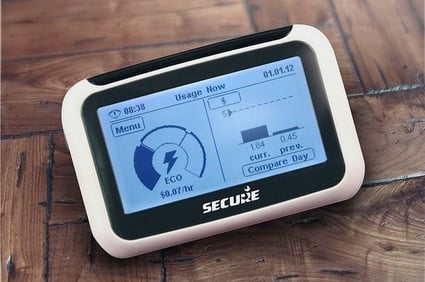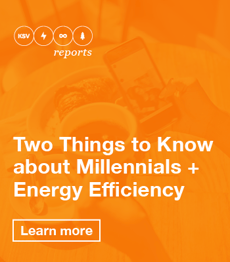One of the inspiring parts of working in the energy vertical is all of the innovation, disruption, and incredible minds that are working to create solutions.
Enter Elizabeth Palchak.
A few months ago KSV had the opportunity speak at the BECC Conference and present on millennials, and got to hear a great presentation by Elizabeth Palchak at UVM (Elizabeth also does work for VEIC because she's a rockstar).
Elizabeth has been studying (among other things) the impact of in-home displays on energy efficient behavior and awareness in a renting millennial crowd, and her findings were fascinating.
So today, Elizabeth is joining us on EnergyWire, and sharing some of the results of her research with you.
Hi @E_Palchak, thanks for sharing your research with us!
My pleasure. I love the work you’re doing at KSV, too.
So tell us about the premise of your research.
At the University of Vermont, my colleague Dan Fredman and I designed an experiment to test the impact of In-Home Displays on students’ energy use in off-campus apartments.
An In-Home Display (IHD) looks like an IPad and receives a wireless signal from a “smart” electricity meter mounted on the building. It can display real-time information on electricity usage – and depending on where the IHD is set-up, you can have this information displayed in your living room, kitchen or anywhere else it makes sense for you.

We tested several hypotheses, including the hypothesis that students who had IHDs would reduce their electricity usage. We also captured information on the “energy culture” of our population with surveys and interviews, asking questions about how often people talked to their landlords about energy efficiency, how often they talked to their friends about energy use and where they got their information.
And why did you decide to study this?
There’s a growing field of study that finds a lot of promise in behavior-based approaches to energy reduction. We can insulate our roofs and install efficient appliances, but if we’re still leaving all of the lights on, walking around in t-shirts during the winter in our homes or never unplugging our devices, we’re still using energy. Things like real-time information on electricity use, setting goals for electricity use, and comparisons to our neighbors energy use have demonstrated the potential to change our behavior and reduce the cost of energy bills.
I focused on Millennials’ energy use because there are indications that this group is fundamentally changing the energy sector. They are the ones who brought us the fossil fuel divestment movement and similar to what KSV has found, millennial consumers are asking more of utility companies. Research indicates that this group wants their values to align with their investments and purchasing decisions. It’s a group that has grown up with climate change and this is driving their value set.
Ok, so tell us about your findings. What were the top three things that you learned?
1. More information is probably not enough. Installing IHDs in millennial consumers’ homes did not necessarily change behavior. Importantly, all of the people involved in our study were renters and the survey data showed that these people were not more likely to talk to their landlord about energy efficiency after the study. This means that simply giving people information on kilowatt hours used and the price of each kilowatt hour, might not be enough to fundamentally change home energy use in the renter population.
2. Old ways don't reach new customers. Most millennial consumers in our study searched for information on energy efficiency on the internet, but also got information from parents and professors. Efficiency Vermont is an incredible resource in Vermont for all things energy efficiency – but very few of the people in our study were relying on this organization for information and ideas. This indicates that Millennials are getting information in new ways and it’s imperative that utilities find ways to reach them. Social media is, of course, an important element to consider.
3. Make it personal. In our interviews, we asked about ideas to improve the IHDs. One of the themes that arose was the participants’ desire to have more specific, tailored information that was interactive. Participants asked for text message alerts on energy use, interactive tracking capabilities and appliance-level information. This supports some of KSV’s findings, that millennial consumers want their energy information interactive and individually tailored.
And how do you think utilities could be utilizing this information to their benefit?
Utilities will have to evolve quickly to meet the needs of this demographic. Social media will become a more important communication tool for utilities, so hiring people with social media skills is critical. Energy use information will need to be tailored to individual consumers. And more than ever before, this demographic supports renewable energy, plans to install solar and will pay for it.
In our survey, 94% of respondents answered affirmatively that they are concerned about climate change.
This is driving energy use behavior and presents a huge opportunity for renewable energy, energy efficiency and new approaches for utilities. I’ll also add that there was huge interest in our study from students at UVM. They liked the idea of technological gadgets to reduce their electricity use – there is an opportunity here! But in the end, the devices may not have had the effect we had hoped for. So in addition to everything else, we have to get the technology right.
______________________________
Thanks to the awesome Elizabeth Palchak for her contribution to EnergyWire, we'll be watching her work and bringing you even more insights from industry leaders in 2017.
Want to get in touch with Elizabeth? We'd be happy to make an introduction, just shoot us an email anicholls@ksvc.com
Want even more on millennials? Check out our millennial brief.
Want to be featured in EnergyWire? Reach out to Noelle Palumbo npalumbo@ksvc.com

